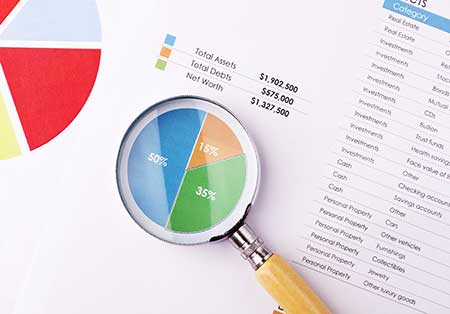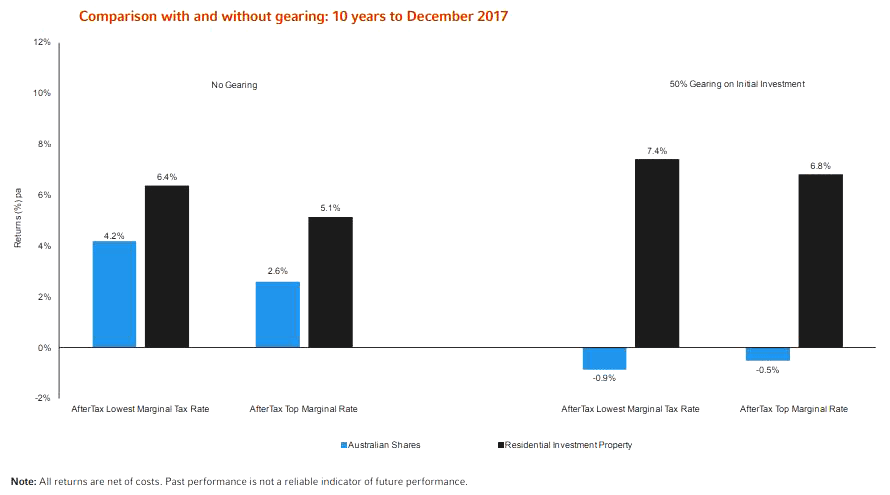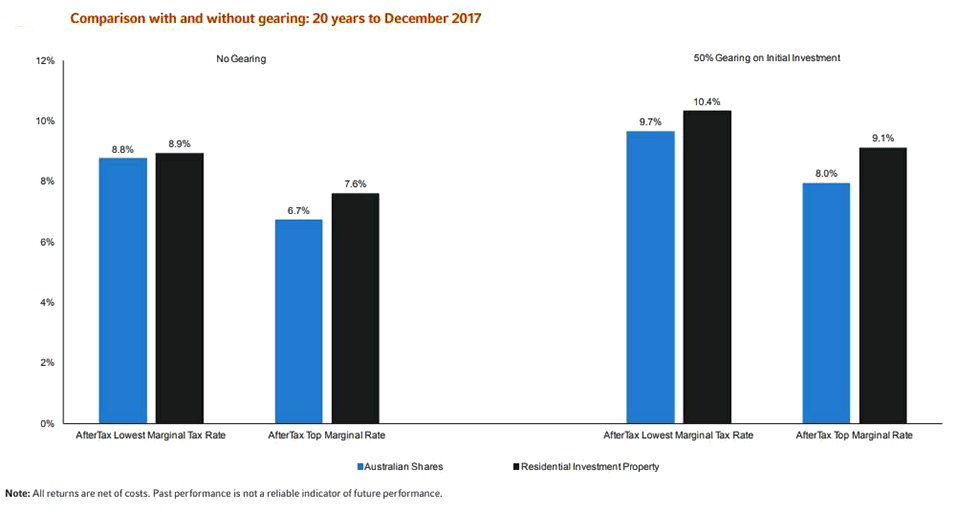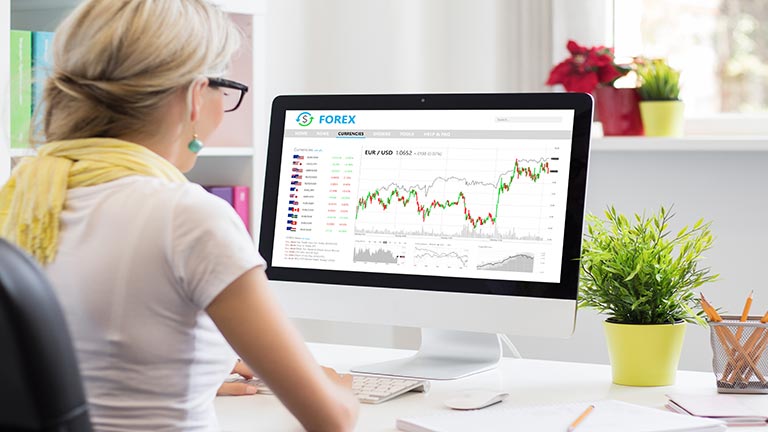Property vs Shares: The Definitive Guide

By Dale Gillham
The age-old debate of property versus shares continues to spark dialogue among investors looking for the best opportunities to grow their long-term wealth. Both investment options come with their own unique set of advantages and challenges, making it essential for investors to weigh up the risks and rewards based on their own financial goals, tolerance to risk and investment time horizon.
In this definitive guide, we delve into the key differences between property and shares and discuss which asset may be the better option based on your personal financial circumstances. We also discuss why we get conflicting answers on the debate around property versus shares and I share why it's important to consider investing in both assets to accumulate wealth.
The property versus shares debate
Depending on who you listen to, you will often find that one investment is favoured over the other. Indeed, the persistent debate comparing the returns on shares with the returns on property tends to vary depending on market conditions and the writer's bias.

As a share trader and an accredited educator in share trading, I could write this article in favour of shares. However, I am also a property investor and I believe that any intelligent investor needs to be in both markets.
The truth of the matter is that it is very hard to compare these two markets simply because we are not comparing apples with apples. There are many different variables to consider when investing in either market; for example, leveraging, taxation, interest rates, risk and holding costs to name a few.
Then we need to consider what aspects of these markets we compare to provide a fair and unbiased analysis. Do we compare the All Ordinaries Index with the Melbourne property market, the Victorian property market or the Australian property market? And should we compare capital growth or capital growth and income?
The combinations are endless and as evidenced in many other articles written on this topic, it is possible to deliver any outcome depending on your bias and make it look like we have settled the dispute once and for all.
That said, we can compare the key differences in regard to the investment opportunities they present, as well as the risks.
Comparing property and shares: Key investment differences
Some claim that you would be better off investing in property rather than shares, as this asset is more tangible and potentially represents less risk. However, what I want to propose is that you can benefit tenfold by investing directly in shares as well as property.
While property investments typically require a larger initial capital outlay compared to shares, they offer investors greater control and leverage over their money. Shares, on the other hand, provide easier access to diversification, liquidity, and potentially higher returns over time. Both investment options have their own set of risks and rewards, which depend on various factors, such as market conditions, personal financial goals, and your tolerance to risk.
So, let's investigate the key investment differences.
1. Capital growth potential
For most people, investing in property is a long-term buy-and-hold strategy where “time in the market” yields good capital growth potential. When you buy a property, it will remain relatively unchanged as an investment for decades except for general maintenance.
Shares, on the other hand, should never be treated as a long-term investment, rather they are a short to medium-term investment vehicle where “timing’ the market” is far more important than time in the market. When it comes to shares, timing the market is everything simply because it is about buying low and selling high. As a consequence, shares can provide higher returns than property, which I show you later in this article.

2. Market volatility
Property investments also tend to exhibit lower volatility compared to shares, making them more attractive to risk-averse investors. However, shares can provide higher returns in shorter timeframes, which is appealing to those who have the knowledge and skill to consistently profit from the stock market.
3. Income generation
Property investments can generate consistent rental income, while shares can produce dividend income. There is conjecture on which option provides a more reliable income stream, as rental income depends on tenant demand and market conditions, while dividends are subject to company performance and payout policies.
That said, investing in stocks out to the top 50 on the ASX can generate a solid dividend income.
4. Diversification
Property investments can offer diversification opportunities, although they may require more effort and capital compared to shares. Shares also offer the advantage of diversification, allowing investors to spread their risk across a variety of companies and sectors, which is much easier to achieve as it requires a smaller capital outlay.
5. Liquidity
Liquidity refers to the ease with which an asset can be bought or sold in the market without significantly affecting its price. Shares tend to be more liquid than property investments, meaning they can be bought and sold more quickly, which can be crucial during periods of market volatility.
6. Higher returns
Property investment can offer various forms of return, depending on the type of property, investment strategy, and market conditions. However, over the longer term, shares are likely to provide higher returns, although this will depend on various factors, such as the performance of individual stocks and the broader market trends.
7. Leverage and debt
Property investments often involve the use of leverage through mortgages, which can amplify returns but it will also increase risks. Unfortunately, the debt on property investments can lead to significant financial stress during market downturns or when interest rates rise. In contrast, shares typically involve less leverage, which reduces the risks associated with debt. That said, leveraging can cause significant financial stress during market downturns if you don’t know how and when to exit your positions to preserve your capital.

8. Management and control
The appeal of property investments is due to the direct control investors have over these assets. In contrast, share investors have limited control over company management and decisions, which can impact their investment performance. However, investors do have control over when they enter and exit a stock to ensure they are compounding their returns.
9. Barriers to entry
Property investments usually require a more significant capital outlay and they have ongoing expenses compared to share investments, which have lower entry costs. While this accessibility makes shares more appealing, in my opinion, both investments are essential for accumulating wealth, as each assists you in investing in the other, given that when you invest in shares using my four golden rules, it provides the cash flow to invest in property and property provides you with leveraging opportunities to trade shares.
Both property and shares carry their own set of risks and rewards, which can vary depending on factors, such as market conditions, interest rates, economic trends, and geopolitical events. Your own financial goals and tolerance to risk will also play a significant role in determining the most suitable investment option for you.
By understanding the key differences between these two investment options and evaluating your personal financial goals, you can make informed decisions that best align with your financial objectives.
Now let's investigate the return on property versus shares.
Investing in property vs shares
Based on the latest Russell/ASX Long-Term Investing Report, the 10-year after-tax return (including costs) at the highest marginal tax rate for Australian shares was only 2.6 per cent compared to property, which was 5.1 per cent. In comparison, the 20-year after-tax return at the highest marginal tax rate (including costs) for Australian shares was 6.7 per cent compared to property, which was 7.6 per cent.
So in both cases, property outperformed shares.
However, both scenarios do not take into account leveraging (or gearing) that is normally associated with a property investment. Therefore, if we were to compare the returns on shares versus property based on gearing of 50 per cent, then at the top marginal tax rate, property still fared significantly better than shares. This is because the Australian stock market performed poorly during the period these comparisons were done. Since then, the property market continued to rise before it started to pull back in 2022 due to interest rate rises.

Source: Russell Investments/ASX Long Term Investing Report
But if we compare the 20-year return, the difference between the after-tax return at the top marginal tax rate for property and shares is only marginal at 0.9 per cent.

Source: Russell Investments/ASX Long Term Investing Report
As these examples demonstrate, buying an investment property over the long term will yield high returns if you buy in good capital growth areas. For example, houses in Melbourne have risen historically at an annual growth rate of 5.9 per cent over the last 30 years to June 2022, according to CoreLogic, while at a national level, it has grown by 5.4 per cent.
Buying and selling property over the short term, however, has generally yielded very little results due to the high transaction costs and long periods of low growth. Indeed, it is well known that property generally has strong growth for two to three years within a ten-year period, and then only increases marginally better than inflation during the other seven years.
This is supported by CoreLogic who confirmed in their 2022 report that over the last 30 years, we have seen six distinct cycles of growth and an equal number of cycles of decline. Each of the upswings and downturns was characterised by different environments and catalysts of change such as taxation policy, monetary policy decisions, economic shocks, fiscal stimulus and broader economic conditions.
Having now read this, some would argue that this supports the perennial debate that property is the better asset to invest in. But what if you could achieve returns in the stock market that are equal to or better than the returns you achieve from investing in property and compound your returns substantially?
Buying and holding shares: Is it a good long-term strategy?
The reason why most of us hear the words “buy and hold” or it is time in the share market that yields returns is because the institutional funds cannot time the market, they are just too big to manoeuvre with any speed.

Anyone who has dealt with a financial adviser about investing in the stock market would be familiar with the adage that you need to hold onto a portfolio for 10 years or more to yield an adequate return.
In essence, this allows the investor to experience a rising market 30 to 50 per cent of the time to compensate for the years that the market is moving sideways or down. If you don’t believe me, just look at the returns on institutional funds over the past 10 years - at least 80 per cent have underperformed.
Therefore, to accept that time in the market is more important than timing the market is probably the greatest downfall of anyone wanting to beat the market average.
The reality is that using a “buy and hold” strategy will see gains during bullish periods in the stock market decimated when the bears take control in a bearish market, as we saw occur during the Global Financial Crisis (GFC) and other previous major market declines. In contrast, with a little bit of knowledge, a more active approach will allow you to participate during the bullish run and sit on the sidelines when the market trades sideways or down.
Using a share investment strategy to acquire property
It is possible to leverage the growth potential and liquidity of shares to acquire property by regularly investing in a diversified portfolio of shares. By focusing on capital appreciation and reinvesting your dividends, you can grow your wealth. As the value of the share portfolio increases, it can be partially or fully liquidated to provide the necessary capital for a deposit to purchase a property.
This approach ensures you benefit from the advantages of both shares and property, as you are combining the potential for higher returns and the liquidity of shares with the stability, leverage, and tangible nature of property investments. Let me share how this is achievable.
Actively managing a share portfolio
As many who actively trade the share market know, timing the market is everything, as it alleviates the problems associated with having your capital tied up for years in unproductive investments that are present with a buy-and-hold strategy.

Unlike fund managers, who must invest your capital when they receive it irrespective of whether the market is rising or falling, you have the flexibility to diversify the timing of your entry and exit to ensure you only invest when the market is rising.
And the good news is you can do this using a low-risk, methodical approach that ensures you maximise your profits while minimising your risk.
In my latest award-winning book, Accelerate Your Wealth – It’s Your Money, Your Choice, I demonstrate how you can achieve returns that not only outperform the institutional funds by a significant margin but also rival or outperform the returns you achieve from investing in property. And you can do this in as little as a few hours a month once you establish your portfolio.
In my book, I actively traded a portfolio of the top 20 stocks on the ASX over 10 years from 2 January 2007 to take into account the effect of the GFC and the market volatility that followed. The gain achieved from capital growth and dividends during the period to 31 December 2016 was 225.82 per cent or an average annual return of 22.58 per cent, which you would have to say is pretty impressive. This equates to an annual compounded rate of return of 12.54 per cent. Obviously, the real return will be lower after factoring in capital gains tax and inflation.
But that aside, what I demonstrate is that individuals can achieve very rewarding returns without taking high risks or speculating. It may surprise you to learn that I achieved this outcome using a ruler and pencil to apply trend lines in combination with a stop loss to protect capital. In comparison, the return on managed funds, as published by Canstar Research, over the same ten-year period represented only 4.67 per cent.
So, not only can you achieve very profitable returns but you also have the potential to outperform the institutional funds using some simply do-it-yourself stock market investment strategies. What this demonstrates is that it is possible to leverage the growth potential offered by shares to raise the initial capital required to purchase a property. The benefit of investing in both shares and property is that you can compound your returns substantially.
Remember, however, it's essential to monitor market conditions, maintain a well-diversified portfolio, and assess your tolerance to risk to ensure the success of this strategy.
Others who read this article also enjoyed reading:






